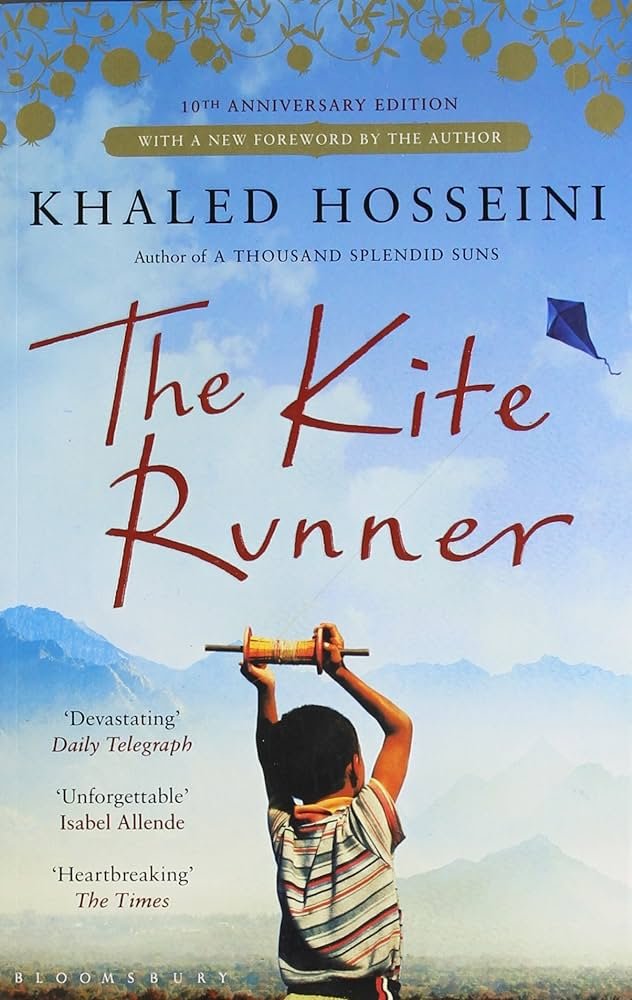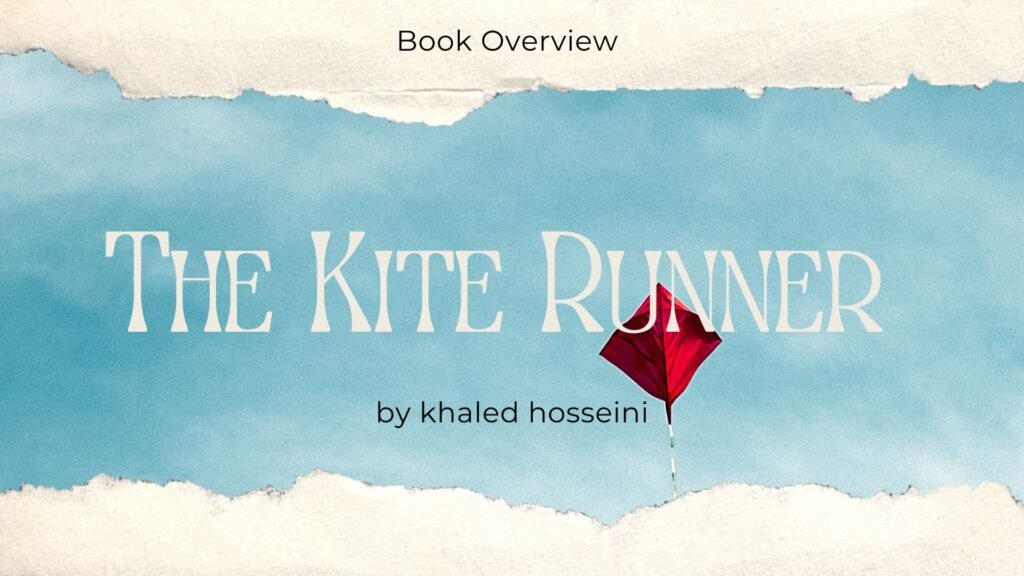Khaled Hosseini’s The Kite Runner is a powerful story of loyalty, betrayal, and redemption. This book was published in 2003, and it quickly became a global favorite.
The novel brings Afghan culture to life. It takes you on an emotional journey through the eyes of its main character, Amir.

Book Summary of The Kite Runner
Here’s a detailed summary of this unforgettable book.
Introduction to the Main Characters
- Amir: The protagonist
- Hassan: Amir’s loyal friend
- Baba: Amir’s father
- Ali: Hassan’s father
- Assef: The antagonist
Amir is the main character. He is thoughtful and sensitive. He grows up in the shadow of his father, Baba. Baba is wealthy and respected. He struggles to connect with Amir, who loves reading and writing instead of physical activities.
Hassan, the son of Baba’s servant Ali, is brave and loyal. He is also great at kite running. You see a close bond between Amir and Hassan. However, their social status creates an invisible barrier.
Ali, Hassan’s father, is quiet but loyal. He serves Baba faithfully. Then there’s Assef, the neighborhood bully. He represents hatred and cruelty. His actions have a devastating impact on Amir and Hassan’s lives.
Context of The Kite Runner
The story is set in Kabul, Afghanistan, during the 1970s. At that time, the country was mostly peaceful but starting to face political troubles.
The novel shows a clear picture of Afghan society. It highlights the big gap between the wealthy Pashtuns, like Amir’s family, and the poorer Hazaras, like Hassan and his father, Ali.
These social and ethnic divides shape the characters’ actions and add tension to the story.
As the story progresses, Afghanistan’s situation worsens. The monarchy falls, and the Soviet invasion brings chaos. This political turmoil mirrors the characters’ struggles. The country’s descent into violence reflects Amir’s own loss of innocence.
Plot Summary Overview
The novel takes you through Amir’s journey. He starts as a privileged but insecure child. Over time, he grows into a man seeking redemption for his past mistakes.
The story focuses on loyalty, loss, and betrayal. These themes shape the relationships between Amir, Hassan, and Baba.
Through their interactions, you see a deeper message. Hosseini shows how societal pressures and personal insecurities can lead to choices with lasting consequences.
Amir and Hassan: The Bond of Friendship
At its core, The Kite Runner is a story about friendship.
Amir and Hassan grew up together in Kabul. They play in the streets and fly kites under the Afghan skies.
But their friendship isn’t equal. Amir is a Pashtun, part of the dominant ethnic group. Hassan is a Hazara, an ethnic minority often treated unfairly.
Hassan is deeply loyal to Amir. He would do anything for him. But Amir doesn’t always return this loyalty. He struggles with guilt and jealousy. This grows worse when he thinks Baba favors Hassan more than him.
The Kite Running Tradition
Kite running is an important symbol in The Kite Runner. It’s a popular activity in Afghanistan. During the annual kite tournament, the goal is to cut down other kites. The last kite flying becomes the ultimate prize.
For Amir, winning the tournament means more than victory. He sees it as a chance to earn Baba’s approval. Kite running is one of the few things that connects them.
Hassan, who is a skilled kite runner, makes a promise to Amir:
“For you, a thousand times over.”
This line captures Hassan’s deep loyalty and sets the stage for everything that happens next.
The Turning Point: The Winter of 1975
The story’s turning point happens in the winter of 1975. After Amir wins the kite tournament, Hassan goes to retrieve the fallen kite as he promised. But he encounters Assef and his gang.
What happens next is horrifying. Assef assaults Hassan. Amir sees it but does nothing. He is too scared and ashamed to intervene.
This moment changes everything for Amir. His guilt and cowardice stop him from helping Hassan. Afterward, he begins to distance himself from his friend. This guilt becomes the emotional conflict that drives the rest of the story.
The Fallout of Betrayal
Amir’s betrayal doesn’t stop with him just staying silent. He feels overwhelmed by guilt and starts treating Hassan badly. He hopes that pushing Hassan away will ease his own suffering.
But things only get worse. Eventually, Amir’s cruel actions lead to Hassan and Ali leaving Baba’s household. This decision haunts Amir for the rest of his life.
Amir and Baba’s Journey to America
As political tensions grow in Afghanistan, Baba and Amir flee the country. They leave behind their wealth and status.
They settle in California, where Baba takes on menial jobs. Amir slowly adjusts to life in America.
The move gives Amir a chance to start fresh. But the emotional scars from his betrayal stay with him.
Amir’s Inner Struggles
Even though Amir is safe in his new life, he can’t escape his past. The guilt from betraying Hassan still haunts him. It impacts his relationships and his sense of self-worth.
Even with success as a writer and a beautiful wife, Soraya, Amir feels incomplete. He knows he won’t truly be happy until he faces his past.
Amir’s Return to Afghanistan
Years later, Amir gets a call from Rahim Khan, an old family friend. Rahim Khan tells him there is “a way to be good again” and offers Amir a chance to make up for his past mistakes.
Amir decides to return to Afghanistan. But the country is now under Taliban rule, making the journey dangerous.
Despite the risks, Amir uncovers personal truths, especially about Hassan’s parentage. These revelations force him to face his past mistakes.
Confronting the Past: Amir and Assef
In one of the novel’s most intense scenes, Amir confronts Assef, who is now a Taliban official. Their encounter is brutal and represents Amir’s struggle for redemption.
The fight is raw and visceral. Amir ends up physically scarred, but he finds emotional freedom through this confrontation.
Amir Adopt Sohrab: Hassan’s son
After the fight with Assef, Amir learns that Hassan’s son, Sohrab, has been left orphaned and is in a dangerous situation.
In a final act of redemption, Amir chooses to adopt Sohrab. He wants to give Sohrab a chance at a better life.
Through his new relationship with Sohrab, Amir starts to heal from the wounds of his past.
Themes of Loyalty and Loss
Loyalty is a key theme in The Kite Runner. Hassan’s steadfast loyalty to Amir stands in sharp contrast to Amir’s betrayal. This contrast highlights the emotional depth of their relationship.
Loss is another major theme. The novel explores various kinds of loss, from the loss of innocence to losing family, home, and country. These losses push the characters to grow and change, in painful ways.
Conclusion
The Kite Runner is a powerful story about the human ability for both cruelty and atonement. Amir’s journey shows us that it’s never too late to seek forgiveness. It also reminds us that loyalty and friendship can endure even the deepest betrayals.
The novel explores personal and cultural identity, along with universal themes of love, loss, and atonement. This makes its impact lasting, resonating with readers long after they finish the book.



